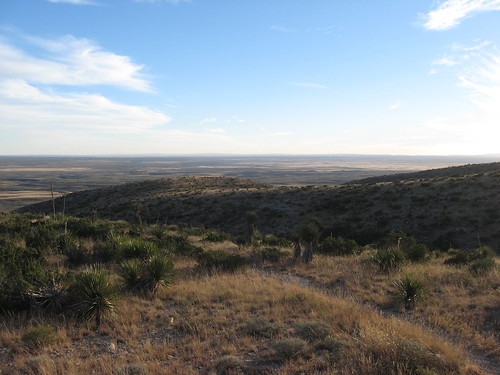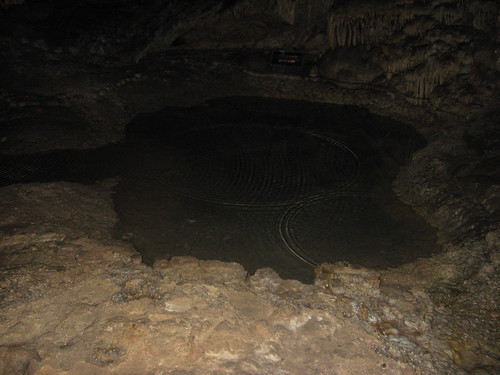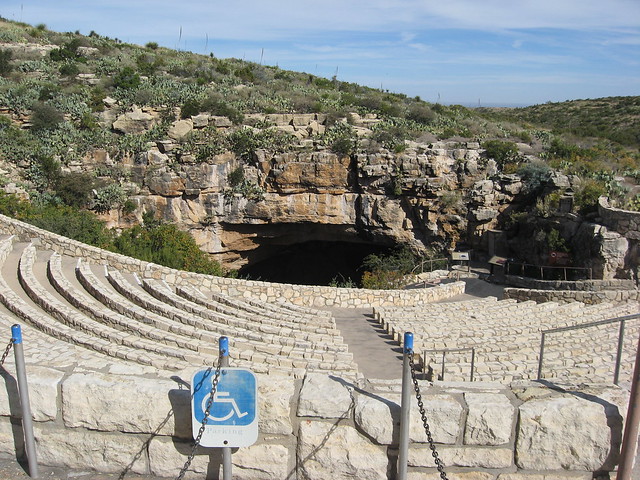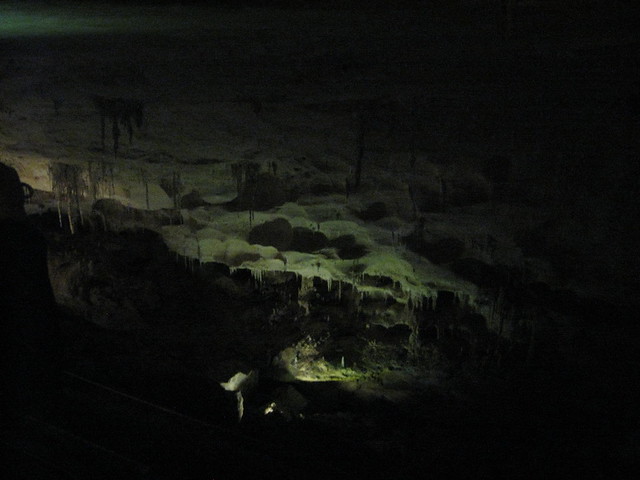
Location: Eddy County in southeastern New Mexico right near the border with Texas, near Carlsbad, NM.
Introduction:
Within about 30 miles of Guadalupe Mountains National Park (Guads), Carlsbad Caverns National Park (Wikipedia page) is the first of the National Park cave systems that I visited. As with the Guads this national park is located in the high desert of the American Southwest. The surface footprint of the National Park is much greater that what would be expected if it was to just be the cave itself and as such there are many other activities to see and do including many great views as well as being able to visit other entrances to the cave system. If you are hitting up one of the two parks in the region you are doing something wrong since they are both so close and both offer many different options to explore.
Geology
 As you might expect the geology of Carlsbad Caverns is very similar to that of the Guads so if you have not read my write up on that I suggest you do. A quick summary for those who have but may not remember it all. In the Permian the area that now includes Carlsbad Caverns and the Guadalupe Mountains was covered by a warm, shallow sea that allowed for the growth of organism that secreted calcium carbonate in a primarily sponge-reef. The sea eventually began to dry and covered up much of the reef in evaporites. Overtime these calcium carbonate rich rocks were lithified to form a large primarily limestone deposit. This limestone was eventually uplifted and formed the mountains and ridges in this area.
As you might expect the geology of Carlsbad Caverns is very similar to that of the Guads so if you have not read my write up on that I suggest you do. A quick summary for those who have but may not remember it all. In the Permian the area that now includes Carlsbad Caverns and the Guadalupe Mountains was covered by a warm, shallow sea that allowed for the growth of organism that secreted calcium carbonate in a primarily sponge-reef. The sea eventually began to dry and covered up much of the reef in evaporites. Overtime these calcium carbonate rich rocks were lithified to form a large primarily limestone deposit. This limestone was eventually uplifted and formed the mountains and ridges in this area. Now I can expand on something I mentioned in passing when I talked about the Guads is the formation of caves which this post will allow me to expand on. Caves form primarily in limestone rich areas which are typically known as karst areas, why? The answer is simply that limestone breaks down easily in acid rain. All rain has some acidic qualities in it these are picked up as the rain water passes through atmospheric CO2. When the CO2 is present in the atmosphere and gets taken up by water it forms carbonic acid but it is typically pretty weak in the rain water itself. As the rain water can either run off into rivers and lakes and eventually the ocean or it can penetrate the surface and reach the water table. As the water moves underground if it reaches a limestone rich deposit the carbonic acid will react with the limestone, this dissolves away a part of the limestone and releases CO2 back into the atmosphere. This dissolved water is part of the reason why people who have well water will get hard water stains etc a lot of times. Also of some interest this is another reason why scientist worry about excess CO2 in the atmosphere because it causes the oceans to become more acidic making it more difficult for calcite secreting organisms, coral etc, to secrete calcite and can cause them to actually dissolve over time, this is called ocean acidification. Over a long period of time the water can dissolve away large areas of the limestone and form caves and as the water table drops or the area with the cave is uplifted these caves become exposed at the surface where we find them. Another interesting thing that can happen is that the water can get supersaturated in lime at higher subsurface pressures and when this water reaches the surface, or a depressurized cave, it will drop this lime off and form a special kind of limestone called travertine. Travertine is what typically is found on the edges of cave walls as well as in many of the formations in the cave.
Now I can expand on something I mentioned in passing when I talked about the Guads is the formation of caves which this post will allow me to expand on. Caves form primarily in limestone rich areas which are typically known as karst areas, why? The answer is simply that limestone breaks down easily in acid rain. All rain has some acidic qualities in it these are picked up as the rain water passes through atmospheric CO2. When the CO2 is present in the atmosphere and gets taken up by water it forms carbonic acid but it is typically pretty weak in the rain water itself. As the rain water can either run off into rivers and lakes and eventually the ocean or it can penetrate the surface and reach the water table. As the water moves underground if it reaches a limestone rich deposit the carbonic acid will react with the limestone, this dissolves away a part of the limestone and releases CO2 back into the atmosphere. This dissolved water is part of the reason why people who have well water will get hard water stains etc a lot of times. Also of some interest this is another reason why scientist worry about excess CO2 in the atmosphere because it causes the oceans to become more acidic making it more difficult for calcite secreting organisms, coral etc, to secrete calcite and can cause them to actually dissolve over time, this is called ocean acidification. Over a long period of time the water can dissolve away large areas of the limestone and form caves and as the water table drops or the area with the cave is uplifted these caves become exposed at the surface where we find them. Another interesting thing that can happen is that the water can get supersaturated in lime at higher subsurface pressures and when this water reaches the surface, or a depressurized cave, it will drop this lime off and form a special kind of limestone called travertine. Travertine is what typically is found on the edges of cave walls as well as in many of the formations in the cave.Animals have always played a large role in the environment of caves and the most typical animal that people think of with caves is bats. Carlsbad Caverns is no exception to this and during the summer you can watch the bats fly out of the cave at night, I hear this is an awesome sight but one which I have not yet seen. Other animals also use the caves and deep within the cave system it becomes an environment like no other. A karst system can form many openings into the cave system on the surface some of which may be nearly vertical or just impossible for a surface animal to escape from. This leads to the possibility of fossils being found in caves and in fact they have been found in this cave as well as others around the world. If you really wish to learn how these fossils may get preserved I recommend this post over at History of Geology, yes I know I have mentioned it before. I'm sure I am missing some aspects so if you have questions feel free to ask them in the comment section below and I will try to answer them.
More Pictures I have even more in the Carlsbad Caverns portion of my Flickr page.




Further Reading:
National Park Service's web page on the Geology and on the Caves
While only partially related: Bebout, D.G. and Kerans, C. 1993. Guide to the Permian Reef Geology Trail, McKittrick Canyon, Guadalupe Mountains National Park, West Texas. Bureau of Economic Geology, Austin, 48 p. (I really recommend this last one if you are going to do the geology trail (of the Guads) because it includes stops and talks about the geology of the are. A digital copy can be found here but I recommend buying one from the park when you get there [the Guads], support your parks!!!)
National Park Service Series homepage

No comments:
Post a Comment